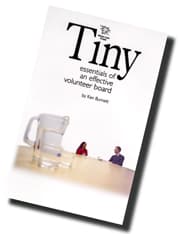How, precisely, do you build a better board? Part 1
The trouble with nonprofit boards… ‘The trouble with most trustee boards is that they appoint the charity’s CEO and senior management, rather than the other way around.’
- Written by
- Ken Burnett
- Added
- June 17, 2011

Saying this is my irascible but scarily competent friend Serena Goody, CEO of a medium-sized childcare charity. She’d been bending my ear one evening about the problems she has with her board of trustees, particularly her chairman. It’s a familiar topic among senior folk in many nonprofits of my acquaintance. In voicing her view the forthright Serena speaks for many working in the burgeoning, ever-more significant voluntary sector. ‘Our trustees just don’t understand’, she went on, describing some conflict or other, ‘but feel that because they’re there, they have to interfere.’
My pal and I had been debating the relative merits and shortcomings of managing a charity as opposed to running a more conventional commercial enterprise. ‘One thing that’s noticeably different’, Serena complained (and she speaks with knowledge, having joined the sector after many years in a senior role with one of Britain’s top companies), is the presence of that strange extra layer of unpaid part-time directors, the board of trustees.’ (I paraphrase her considerably here. Her language was a bit stronger.) She went on to describe the overlap and frequent misunderstandings that arise between her trustee board and her own full-time team of paid senior managers, which she considers the ‘real’ board of directors of the charity. While almost all aspects of nonprofit management have professionalised in recent years, she told me, to a point where the old image of well-meaning, soppy amateurs has been all but banished, her organisation’s topmost management layer, the board of trustees, still all too often functions just like its familiar stereotype, or worse. ‘They’re well-intentioned, good people giving their time to a cause they believe in’, she emphasised with a mixture of appreciation and exasperation. ‘But where do they add value? More likely, they cause more problems than they resolve.’

These days trustees are more likely to be recognised as a potentially useful, highly valuable group with a unique contribution that needs to be made.
I concluded she had some rather good points. Trustee boards are a strange construct, something of an anachronism, a curious historical oddity. But, I thought to myself, she does scant justice to the potential contribution of a truly effective trustee board. Thankfully, this awareness is rapidly gaining ground among senior managers in nonprofits and trustee boards nowadays are less likely to be seen as barriers or irrelevant, to be kept in the dark and fed only what staff assume will keep them docile. These days they’re more likely to be recognised as a potentially useful, highly valuable group with a unique contribution that needs to be made.

I concluded she had some rather good points. Trustee boards are a strange construct, something of an anachronism, a curious historical oddity. But, I thought to myself, she does scant justice to the potential contribution of a truly effective trustee board. Thankfully, this awareness is rapidly gaining ground among senior managers in nonprofits and trustee boards nowadays are less likely to be seen as barriers or irrelevant, to be kept in the dark and fed only what staff assume will keep them docile. These days they’re more likely to be recognised as a potentially useful, highly valuable group with a unique contribution that needs to be made.
With this realisation has come appreciation that good boards don’t just happen, that to ensure the optimum structure, balance, composition and conduct of the board requires planning, understanding and investment as well as careful development. It matters because, however worthwhile its aims, a bad board can stifle, frustrate and hold back any voluntary organisation, whereas a truly effective board can make a good organisation great.
We should celebrate our sector’s long and proud tradition of charities governed by volunteers. They represent a spirit of giving and commitment seldom found elsewhere. A voluntary board is low cost, so when it works it delivers great value. It brings in a range of outside professional expertise, people the charity couldn’t otherwise hope to attract, afford, or properly use. Voluntary, part-time trustees bring fresh eyes, energy and experience to the charity’s distinctive range of issues and problems. They are ambassadors and, often, generous donors. At their best they will be challenging, provocative, stretching. They reassure the public, other donors and even the staff. Mostly, they’re nice people, interesting and capable as well as impressive.
Their unique governance role – utterly distinct from management, which is usually the province of appropriate, professional, paid staff – means trustees have to be simultaneously watchdog, guardian, counsellor, mentor, custodian and friend, for all the charity’s stakeholders. It’s not a job everyone can do.
Warren is a less than fully engaged but not untypical board member of a medium-sized welfare nonprofit who, by accident of fate and the conspiracy of his co-trustees, suddenly finds himself propelled into accepting the role of chairman of the board.
But it is a job of some importance. In North America alone there are hundreds of thousands of individuals who serve as trustees, governing organisations with a combined annual income of $billions, even trillions. Properly equipping this many people and ensuring they are right for the important tasks they discharge is no small thing. To achieve its full potential the nonprofit sector has to do everything in its power to make sure boards become enablers not blockers, adding real, measurable value to the organisations they serve.
Warren Maxwell’s keys to good governance

Good governance demands this, of course. And for nonprofits in the first years of the twenty-first century, good governance has just moved right to the top of their agendas. Which brings me to Warren Maxwell’s list of 21 key aspects of good governance.
There must be a million books written on the subject of board governance, or so it sometimes seems. But few are short. And even fewer have at their core a really good list. Even fewer still could be described as easy reading, offering enjoyment while you learn. In an effort to fulfil these triple objectives I created the character of Warren, a less than fully engaged but not untypical board member of a medium-sized welfare nonprofit who, by accident of fate and the conspiracy of his co-trustees, suddenly finds himself propelled into accepting the role of chairman of the board. It is during his Damascus-like conversion and subsequent quest to discover what makes for a truly effective volunteer board that Warren uncovers, for the benefit of boards everywhere, the nonprofit boards’ list to end all lists.
Warren called his list ‘The 21 key aspects of good governance’. Listed below are the first eight, as a taster. Warren’s remaining 13 keys continue in similar vein, though covering quite different points. Lack of space prevents SOFII from presenting them all now, so the remainder appear in a follow-up article on this theme, which you can get to here.
The first eight from Warren Maxwell’s 21 keys to an effective volunteer board:
1. The board serves the organisation, not the organisation serves the board.
High among the indicators of good governance is an absence of pride and pomposity, combined with the realisation that the board is not the top layer of the organisation, it’s just another vital but equal component that must fulfil its role effectively and deliver demonstrable value just like any other part. The board is no place for passengers, autocrats or petty dictators. The board is there to serve.
2. Make sure everyone fully understands the different roles of the board and the management 'top team'. Management manages. The board governs. Define the different roles, making clear what governance means.
The board deals with strategy, management deals with operations. Management proposes, the board approves – or not. So boards will mostly prove to be effective when they are questioning rather than answering.
Any board unable to leave the role of management to the full-time professionals it has appointed to run the organisation is not an effective board. If the CEO hasn’t got the board’s full confidence he or she should be required to improve or leave (or in exceptional circumstances the board or a part of it should leave). The CEO – with the board’s help by all means – should appoint the senior management team. After all, it’s the CEO’s job to make the senior team deliver its objectives. No CEO can be reasonably expected to do this unless he or she has appointed the top management team himself/herself.
3. Agree the Board’s main roles. There are (usually) five.
- Watchdog: guardians of public interest, particularly for donors, beneficiaries and other stakeholders. Guardians of the brand, and reputation.
- Strategic planning (role shared with management) and formal approval and adoption of the strategy.
- Appoint, monitor and if necessary remove the CEO. Approve his/her appointment of management team, assisting as required.
- Support for management, and through them, the staff, to help them do their jobs better and ensure the organisation succeeds.
- Understand the finances of the organisation, read and (having understood them) approve the accounts. Trustees are also required to ensure that their organisation is fully open and accountable in providing a complete and detailed account of what the organisation has done with the money it has raised.
There are exceptions to the above, but not many. Boards can take on additional roles if the management team wishes them to, but given the time pressures under which most board members operate, additional tasks may be unwise as they may dilute the boards’ effectiveness at its core functions…
NB. Different countries may have differing rules or guidelines for nonprofit boards so it pays to familiarise yourself with whatever laws, best practice, or guidance governs the board’s role and responsibilities in your country.
4. With the CEO, prepare a written strategy just covering the board and what it does, that everyone can buy into, board members and senior staff alike.
There are few hard and fast rules on board strategies. Such a document can be slim or fat as tastes and circumstances dictate. It’s probably a good idea to review it from time to time but it can be updated or replaced each year or it can run unchanged for years.
It should be a strategy that fits in snugly with the organisation’s overall strategy. And it’ll have full buy-in if it’s produced jointly with the management team rather than handed down to them from on high. It’ll help if it’s in plain language, stripped of pomposity and jargon and no longer than it needs to be.
It is important to know to whom the board is accountable. Many countries have legislation and established regulatory mechanisms that cover this. Those that don’t will depend on a document or charter that establishes the board’s responsibilities and parameters, such as a memorandum of understanding or articles of association. Boards often have many stakeholders and it is important that these have clear access to what the board is doing and ways of ensuring it is appropriately accountable.
5. Keep the CEO involved (and management team too). Never meet without the CEO, unless in a crisis that involves replacing the CEO.
Traditionally boards love to be secretive and frequently gather behind closed doors. While some circumstances necessitate confidentiality, most of a board’s business doesn’t need to be secret so should be conducted openly and transparently. A good board has a duty to share its processes and outcomes not just with management and other staff but with supporters and other interested audiences too.
6. Immerse all board members in the board’s mission. Let trustees see the work personally, for themselves.
Your board members need to fully understand the work of the organisation they are to govern. That means that there is no substitute for experiencing it themselves, in person,. The nature of the work that your organisation does means this will be easier for some organisations than it will be for others. But it is almost always worthwhile and should be seen as an essential part of good governance.
7. Work with the management team to produce a rolling organisational strategy. Ensure there is universal commitment to this strategy, ‘the glue that binds us together’
Facilitating and approving the organisation’s strategy and the process that produces it is one of the most important of the board’s roles. For the strategy to work, it’s essential that the whole organisation is involved in its drafting and that the process is fair, transparent and well-managed.
8. Reduce paperwork. Make sure your meetings serve the need of the organisation, not the trustees
Most boards produce too much paper which is an unnecessary burden not just for the trustees and others who have to wade through it all but, perhaps more importantly for the, usually, hard-pressed staff who have to prepare it and often spend weeks and even months in the task.
A minimum level of paperwork is of course both desirable and necessary and it is the board’s task not to set that level, but to work with the senior management team to ensure it has the paperwork it needs, but no more.
© Ken Burnett 2008


















